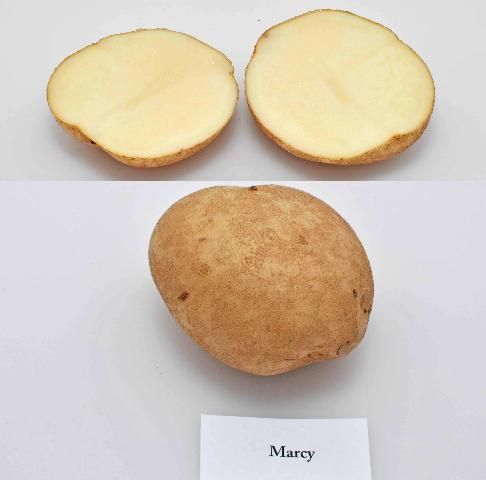There are several potato varieties available in the market today. Most of them have been bred or developed in production regions other than Florida. The University of Florida Potato Variety Evaluation Program screens new germplasm from public and private breeding programs and identifies the most promising cultivars for commercial potential considering broad adaptability to Florida climate and conditions and market purpose: processing, fresh-market and specialty-type varieties. Over the years, the UF/IFAS Potato Variety Program has become an important reference to vegetable growers, seed producers, processors, crop insurance agencies, and brokers looking for alternative potato varieties to explore different markets, improved characteristics, and yield. This UF/IFAS Potato Variety Trials Spotlight presents a summary of the field evaluation of tuber yield and quality performance of the potato variety 'Marcy' cultivated in Florida.
General Comments
'Marcy' is a white-flesh and white-skinned fresh-market potato variety released from the Cornell University Potato Breeding program in 1990. The cultivar was selected from a cross between 'Atlantic' and Q155-3 (De Jong et al. 2006). In trials conducted at the University of Florida, 'Marcy' demonstrated high yield and good tuber characteristics compared to its matched commercial standards, 'Atlantic' and 'La Chipper'. Since its release, 'Marcy' has been cultivated in several trials in Florida. Production and quality results provided here are from variety trials conducted by the University of Florida Hastings Agricultural and Extension Center in 2002 and from 2011 to 2019.

Credit: Lincoln Zotarelli, UF/IFAS
General Characteristics
'Marcy' has white skin with an oval, slightly flattened shape. In field trials, marketable yield ranged from 155 to 326 cwt/ ac and on average was 3% greater than that of 'Atlantic' and 44% greater than 'Red LaSoda'. Approximately 90% of the tuber size distribution was found between the A1 and A3 size classification, which is considered marketable. The specific gravity of 'Marcy' is slightly lower than that of 'Atlantic', but this is not a limitation for the tablestock market. It has greater yield potential than other fresh-market potato varieties adapted for Florida production conditions. The variety was slightly susceptible to hollow heart, corky ringspot, and internal heat necrosis in Florida conditions (Table 3).
Diseases
'Marcy' is resistant to brown rot, common scab, and race Ro1 of the golden cyst nematode. The variety is susceptible to PVX and PVY (De Jong et al. 2006). The standard UF/IFAS Extension recommended disease and weed control program described under Potato Production (Chapter 14 of the Vegetable Production Handbook for Florida, https://edis.ifas.ufl.edu/cv131) should be followed.
Season Length and Growth
Average season length for 'Marcy' for Florida conditions was 95 days. The tuber size should be closely monitored in the weeks prior to vine killing. When desired size distribution has been achieved, vines should be killed. This typically occurs about 85 to 95 days after planting depending on growing conditions during the season. The period from vine kill to harvesting varies by season; however, the plant should be given two weeks for tubers to mature and set skin. For more information on vine-kill chemicals, see Potato Vine Killing or Desiccation (Zotarelli et al. 2016).
Fertilization
During the reported trials, fertilizer was applied two or three times at planting, then once or twice as side-dress applications, once at plant emergence and once when vines reached 6"–8" in height. The cumulative season N rate applied was approximately 200 lb N/acre. The first application of 100 lb N/acre was applied at planting and then also at side-dress (split into one or two applications). Special consideration should be given to the management of nitrogen. Phosphorus and potassium applications follow the UF/IFAS guidelines described in Liu et al. (2019) and normally range between 45 to 100 lb/ac of P2O5 and 170 to 235 lb/ac of K2O, depending on the soil test results.
Planting
Tubers should break dormancy before planting. In Florida, recommended seed pieces of 2½ to 3 oz should be planted 8 inches apart in rows spaced 40 inches apart. Closer in-row spacing reduces harvest tuber size. Excessive soil moisture late in the season degrades lenticel appearance and delays skin set.
Other Information
For additional information on cultivation and management, see the Potato Production chapter of the Vegetable Production Handbook, available at https://edis.ifas.ufl.edu/cv131.
References
De Jong, W. S., D. E Halseth, B. B. Brodie, L. K. Perry, J. B. Sieczka, B. J. Christ, B. J., G. A. Porter, K. M. Paddock, M. W. Peck, and R. L. Plaisted. 2006. "Marcy: A chipping variety with resistance to common scab and the golden nematode." American Journal of Potato Research 83 (2): 189–193. http://link.springer.com/article/10.1007%2FBF02872154
Hutchinson, C. M., J. M. White, D. M., Gergela, P. A. Solano, K. G. Haynes, R. Wenrich, and C. S. Lippi. 2003. "Performance of chip processing potato varieties in northeastern Florida." HortTechnology 13 (4): 706–711.
Liu, G., E. H. Simonne, K. T. Morgan, G. J. Hochmuth, S. Agehara, and R. Mylavarapu. 2019. Chapter 2. Fertilizer Management for Vegetable Production in Florida. In Vegetable Production Handbook for Florida, 2019–2020 Edition. CV296. Gainesville: University of Florida Institute of Food and Agricultural Sciences. https://edis.ifas.ufl.edu/cv296
Sisson, J. A., and G. A. Porter. 2002. "Performance evaluations of potato clones and varieties in the northeastern states-1999." Maine Agr. For. Expt. Sta., Misc. Publ. 751.
Zotarelli, L., P. J. Dittmar, P. D. Roberts, P. Stansly, H. A. Smith, and S. E. Webb. 2019. Chapter 14. Potato Production. In Vegetable Production Handbook for Florida, 2019–2020 Edition. HS733. Gainesville: University of Florida Institute of Food and Agricultural Sciences. https://edis.ifas.ufl.edu/cv131
Zotarelli, L., S. Sargent, P. Dittmar, and M. Makani. 2016. Potato Vine Killing or Desiccation. HS181. Gainesville: University of Florida Institute of Food and Agricultural Sciences. https://edis.ifas.ufl.edu/hs181
Summary of production statistics and specific gravity of 'Marcy' potato variety grown at the UF/IFAS Hastings Agricultural Extension Center, Hastings, FL.